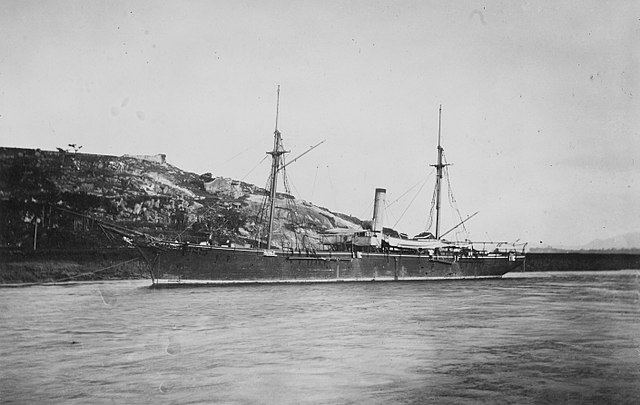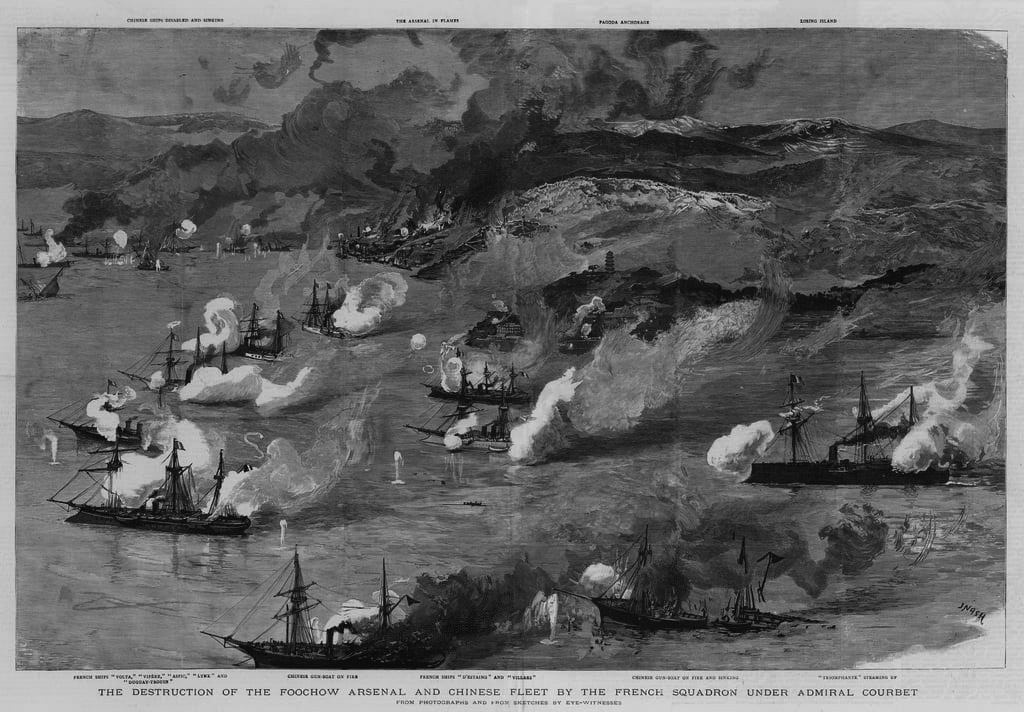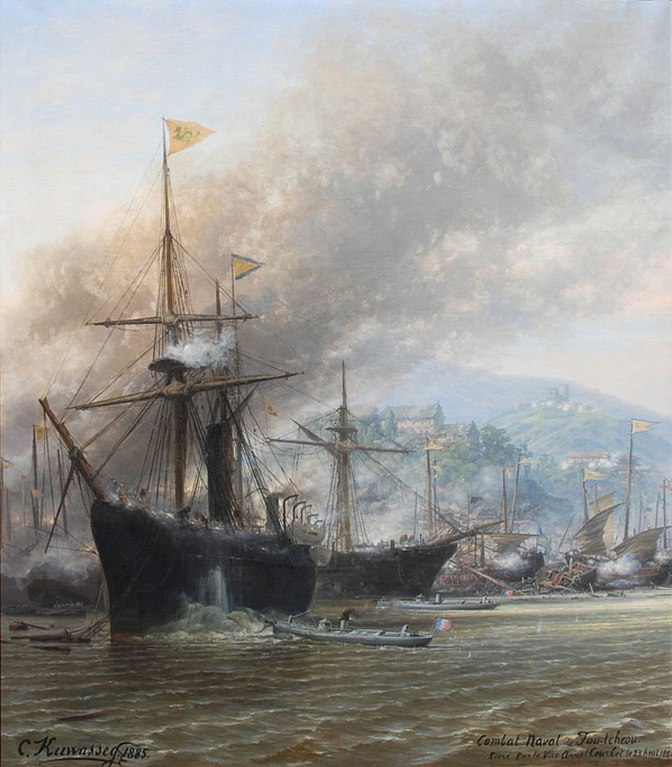
 Imperial Ming Navy – Transport Gunboats
Imperial Ming Navy – Transport Gunboats
Fu Po was the lead ship of six armed transports, built by and for the Imperial Chinese Navy, at the Foochow Arsenal shipyard, all between 1870 and 1876. They were an important milestone, as the first home-built Western-style ships, although stil with wooden hulls. The shipyard at the time was under management by the Imperial commissioner Shen Baozhen, assisted by a diverse staff with engineers from Western nations (mostly French) which acted as advisors. They knew full well about the infancy of ship military grade steel production in China and so advised instead to rely on wooden construction, albeit with a metallic framing. Chinese officials would later blame Prosper Giquel, the chief engineer for to allegedly provide out-of-date equipment and a general design.
About the Foochow Arsenal

The Foochow Arsenal (Fuzhou/Mawei Arsenal also) was one of the modern shipyards ordered to be created by the Qing Empire. It was the first of such, with French assistance at the time during the so-called “Self-Strengthening Movement”. Behind this project were Li Hongzhang and Zuo Zongtang, which decided the best spot would be the town of Mamoi (Mawei) part of the province of Fuzhou (“Foochow”), not that afar from the Min River mouth, on the the access point in mainland China.
At the time, also was established the Fuzhou Naval College and various facilities needed to support a regional fleet, the fourth one. Ot was started in 1866 and port installations in 1867, and the warship construction programme was overseen by two French Naval officers on leave from Napoleon III’s fleet, Prosper Giquel and Paul d’Aiguebelle. They recruited a staff of about forty European engineers and mechanics to create a metal-working forge and naval dockyard and started a construction programme of eleven transports and five gunboats, plus setup the navigation and marine engineering training to form officers and specialists over a five-year plan.

Chinese authorities provided labour and funding for the project, and the site, whihc first comprised about 1,600 workers webt to circa 2,500 by 1872 and the total cost was estimated around 3 million taels. What is amazing is that the ship’s maintenance cost was partly funded by opium imports revenues. Ths first vessel which was launched, in June 1969, was the gunboat Qing Forever with a 150 hp steam engine. Guns were all imported from abroad, apparently either French and Prussian. Next in the 1870s came a serie of sloop of war and transports, notably the Fu Po class which had the yard busy from 1969 to 1875.
The paradox that this shipyard, planned and built by retired French Naval officers and personal, was also destroyed by a French squadron ten years later during the Sino-French War.
Design of the Fu-Po class
Fu-Po herself displaced 1,258 long tons (1,278 t) with a 200 feet (61 m) long hull overall, and 32.8 ft (10.0 m) in beam (6/1 ratio), average 11.5 ft (3.5 m) draught (which enabled going up the Yangtze). The hull had elegant lines, with clipper-style entries and flowing lines to the stern. It was designed to be rigged entirely as a permament fixture alongside the steam engine. The reasoning was that range was more important than speed and space free from coal could be used for storage. She was completed as a two-masted schooner, an easy rigging to master for sailors more accustomed to lattice sails.
Propusion
The propulsion system comprised a compound-expansion steam engine (originl uncertain, some sources states from Vickers), with a single shaft, economical but not great for agility. This engine produced 600 horsepower (450 kilowatts) as indicated. It provided a cruising speed -also her top speed- of 11 knots (20 kph or 13 mph). This was bit weak to act as a commerce raider, more aking to a gunboat and really again underline her role as transport.
Armament
Her main armament was the last thing planned and installed on all ships, depending on the supplies. This was eventually a single 16 cm (6.3 in) gun forward, axial, and four 40-pounder guns () installed on the broadsides. However this changed during their carrier, depending on local provincial supplies where assigned. When assigned to Formosa (now Taiwan), Fu Po obtained six 68-pounder guns () instead.
⚙ specifications |
|
| Displacement | 1,258 long tons (1,278 t) |
| Dimensions | 200 x 32.8 x 11.5 ft (61 x 10 x 3.5 m) |
| Propulsion | One shaft Compound-expansion steam engine |
| Speed | 11 knots (20 km/h; 13 mph) |
| Range | Unknown |
| Armament | 1 x 160mm (6.3 in) gun, 4 x 40-pdr guns |
| Protection | None |
| Crew | 100 |
Read More
Books
Conway’s all the world’s fighting ships 1865-1904 P.398
Elman, Benjamin A. (2005). On Their Own Terms: Science in China 1550–1900. Cambridge, Massachusetts: Harvard University Press.5.
Feuerwerker, Albert; Murphey, Rhoads; Clabaugh Wright, Mary (1967). Approaches to Modern Chinese History. Berkeley
Wright, Richard N.J. (2000). The Chinese Steam Navy. London: Chatham Publishing.
Links
https://www.wrecksite.eu/wreck.aspx?305911
https://en.wikipedia.org/wiki/List_of_ships_of_the_Chinese_Navy_(1644%E2%80%931945)
https://en.wikipedia.org/wiki/Chinese_transport_Fu_Po
https://web.archive.org/web/20220809171626/https://www.navypedia.org/ships/china/ch_index.htm
Model Kits
 Fu Po (伏波) (1870)
Fu Po (伏波) (1870)

Fu Po was the 4th vessel launched at the Foochow Arsenal on 22 December 1870, and lead vessel of the class. Which at the time was assimilated to an “armed transport” but was later considered as a gunboat by the Fujian Maritime Administration. She remained in Foochow until 1884, part of the Fujian Fleet like her sisters, under overall command of Zhang Peilun. Thus she was present at the Battle of Fuzhou on 23 August. It was the first major navale engagement of the Sino-French War.
The Chinese fleet were split into a northern and southern squadrons, and faced the French Far East Squadron (Admiral Amédée Courbet). Fu Po was in the northern squadron like her sisters, led by the flagship Yangwu, with three others “cruisers” and several gunboats. The French squadron concentrated on this northern squadron and soon destroyed Yangwu, completely disorganizing the rest of the line. Under fire and without clear direction, Fu Po fled the battle. She steaming up river and went to beach herself, being the only surviving northern squadron ship at the time.
She would be much later re-floated and refitted and was transferred to the Formosa Squadron (Taiwan). In 1890, she became a receiving hulk for sailors which were awaiting an assignment. Due to a regain of piracy int eh Formosa strait, the Viceroy of the Two Guangs requested her, and in 1893, she was reconverted as a transport, making regular missions in the South China Sea, notably to and from Canton (now Guangzhou). It is unclear when she was scrapped, some sources states in 1911-12 (certainly stricken at the time) and broken up after the revolution, some as far as 1930.
 An Lan (安瀾) (1871)
An Lan (安瀾) (1871)
Second transport cruiser built at the Foochow Arsenal, launched a year after her sister Fu Po, in 1871. Identical on all points, her career was short. She was also assigned to the Fujian squadron under Zhang Peilun. However on 26 September 1874 she was sunk in accident, in deep waters and thus, never refloated.
 Fei Yun (飛雲) (1872)
Fei Yun (飛雲) (1872)
Lie her sisters she was in the Fujian fleet. She was armed with five Prussian breachloader guns. No notable record until the Franco-Chinese war and the Battle of Fuzhou on August 23, 1884. The Chinese flagship “Yang Wu”, was attacked by a torpedo mine boat and ran aground. Fu Xing was attacked and badly burned by gunfire, abandoned and sunk in the middle of the Min River. Zhen Wei was sunk by a single shell (probably hitting the ammo room) from the Ironclad Triomphante, just arrived in the French squadron. Fei Yun was with Chen Hang, Yongbao, Ji’an, Fu Sheng, Jian Sheng all caught and sunk or burned by incendiary shells from Duguay-Trouin, Villars and d’Estaing. So she was eventually sunk that day, and according to Conway Later refloated, but further fate unknown. She is listed as a wreck by wrecksite.eu though.

The Battle showcased one of the first uses of spar torpedo boats. Here N°45 and 46 attacking Chinese ships.
 Chi An (濟安) (1873)
Chi An (濟安) (1873)
Chi An was also part of the Fujian fleet. She served as a sloop of war and transport until the Battle of Fuzhou.
 Yuan Kai (元凱) (1875)
Yuan Kai (元凱) (1875)
Assimilated by many authors as part of the Wei Yuen-class. Fujian fleet. Stricken in 1930. Details unknown (so far)
 Teng Ying Chen (1876)
Teng Ying Chen (1876)
Part of the Fujian fleet, Details unknown (so far), but she was assimilated to the sub-class Wei Yuen, classed as gunboats. She was stricken in 1918 and BU in 1920.
 T’ai An (1876)
T’ai An (1876)
Part of another regional fleet (also named “Tai An”), same as the sub-classe Wei Yuen, classified as a gunboat. Part of the Fujian Maritime Administration, 1,258 tonnes. Away during the battle of Fuzhou, sold in 1892 to commercial (unarmed) and in service until stricken in 1915.
Note: The Battle of Fuzhou:

This was the major engagement in which these vessels participated, was also known as the Battle of the Pagoda Anchorage or Battle of Mawei, the opening engagement of the Sino-French War lasting 16 months, from December 1883 to April 1885. This particular battle started on 23 August 1884 off Mawei harbour, some 15 kilometres South East of Fuzhou. The French shelled the Foochow Navy Yard, razing some building and storehourses, cranes and installations, and badly damaged the sloop Heng Hai still under construction.
The Far East squadron commanded by Admiral Amédée Courbet then encountered the Fujian Fleet, part of the four provincial fleets, assigned to defene the south and strait of Formosa. But the Chinese felee lacked training and some ships lacked ammunition and proper maintenance, crippling their speed. As a result, nine of the eleven ships of the Fujian fleet went down, between HE shells which put them afire (most were still wooden-built), notably the Fu Po class transport sloops, and out-range by French gunners. It was saw as a “gunnery exercize” by the French which only had a few casualties, with just two vessels escaping the mayhem, Fu Po and Vi Xin, already damaged and later abandoned in the Min river.

The bombardment of Foochow. A landing party was prepared but eventually abandoned and instead Courbet went into a rampage back down along the Min River. This Chinese accused the French of cheating since the latter went to Foochow though the Min river only because of peacetime. The entry was protected by fortifications. The two Dingyuan class ironclads which were to be delivered to China, built in Germany, were retained there through French pressure until the end of the war. They would certainly had changed the outcome, but the lack of help from other Provincial fleets was also a factor.

 Latest Facebook Entry -
Latest Facebook Entry -  X(Tweeter) Naval Encyclopedia's deck archive
X(Tweeter) Naval Encyclopedia's deck archive Instagram (@navalencyc)
Instagram (@navalencyc)





 French Navy
French Navy Royal Navy
Royal Navy Russian Navy
Russian Navy Armada Espanola
Armada Espanola Austrian Navy
Austrian Navy K.u.K. Kriegsmarine
K.u.K. Kriegsmarine Dansk Marine
Dansk Marine Nautiko Hellenon
Nautiko Hellenon Koninklije Marine 1870
Koninklije Marine 1870 Marinha do Brasil
Marinha do Brasil Osmanlı Donanması
Osmanlı Donanması Marina Do Peru
Marina Do Peru Marinha do Portugal
Marinha do Portugal Regia Marina 1870
Regia Marina 1870 Nihhon Kaigun 1870
Nihhon Kaigun 1870 Preußische Marine 1870
Preußische Marine 1870 Russkiy Flot 1870
Russkiy Flot 1870 Svenska marinen
Svenska marinen Søværnet
Søværnet Union Navy
Union Navy Confederate Navy
Confederate Navy Armada de Argentina
Armada de Argentina Imperial Chinese Navy
Imperial Chinese Navy Marinha do Portugal
Marinha do Portugal Mexico
Mexico Kaiserliche Marine
Kaiserliche Marine 1898 US Navy
1898 US Navy Sovietskiy Flot
Sovietskiy Flot Royal Canadian Navy
Royal Canadian Navy Royal Australian Navy
Royal Australian Navy RNZN Fleet
RNZN Fleet Chinese Navy 1937
Chinese Navy 1937 Kriegsmarine
Kriegsmarine Chilean Navy
Chilean Navy Danish Navy
Danish Navy Finnish Navy
Finnish Navy Hellenic Navy
Hellenic Navy Polish Navy
Polish Navy Romanian Navy
Romanian Navy Turkish Navy
Turkish Navy Royal Yugoslav Navy
Royal Yugoslav Navy Royal Thai Navy
Royal Thai Navy Minor Navies
Minor Navies Albania
Albania Austria
Austria Belgium
Belgium Columbia
Columbia Costa Rica
Costa Rica Cuba
Cuba Czechoslovakia
Czechoslovakia Dominican Republic
Dominican Republic Haiti
Haiti Hungary
Hungary Honduras
Honduras Estonia
Estonia Iceland
Iceland Eire
Eire Equador
Equador Iran
Iran Iraq
Iraq Latvia
Latvia Liberia
Liberia Lithuania
Lithuania Mandchukuo
Mandchukuo Morocco
Morocco Nicaragua
Nicaragua Persia
Persia San Salvador
San Salvador Sarawak
Sarawak Uruguay
Uruguay Venezuela
Venezuela Zanzibar
Zanzibar Warsaw Pact Navies
Warsaw Pact Navies Bulgaria
Bulgaria Hungary
Hungary

 Bundesmarine
Bundesmarine Dutch Navy
Dutch Navy Hellenic Navy
Hellenic Navy Marina Militare
Marina Militare Yugoslav Navy
Yugoslav Navy Chinese Navy
Chinese Navy Indian Navy
Indian Navy Indonesian Navy
Indonesian Navy JMSDF
JMSDF North Korean Navy
North Korean Navy Pakistani Navy
Pakistani Navy Philippines Navy
Philippines Navy ROKN
ROKN Rep. of Singapore Navy
Rep. of Singapore Navy Taiwanese Navy
Taiwanese Navy IDF Navy
IDF Navy Saudi Navy
Saudi Navy Royal New Zealand Navy
Royal New Zealand Navy Egyptian Navy
Egyptian Navy South African Navy
South African Navy






























 Ukrainian Navy
Ukrainian Navy dbodesign
dbodesign